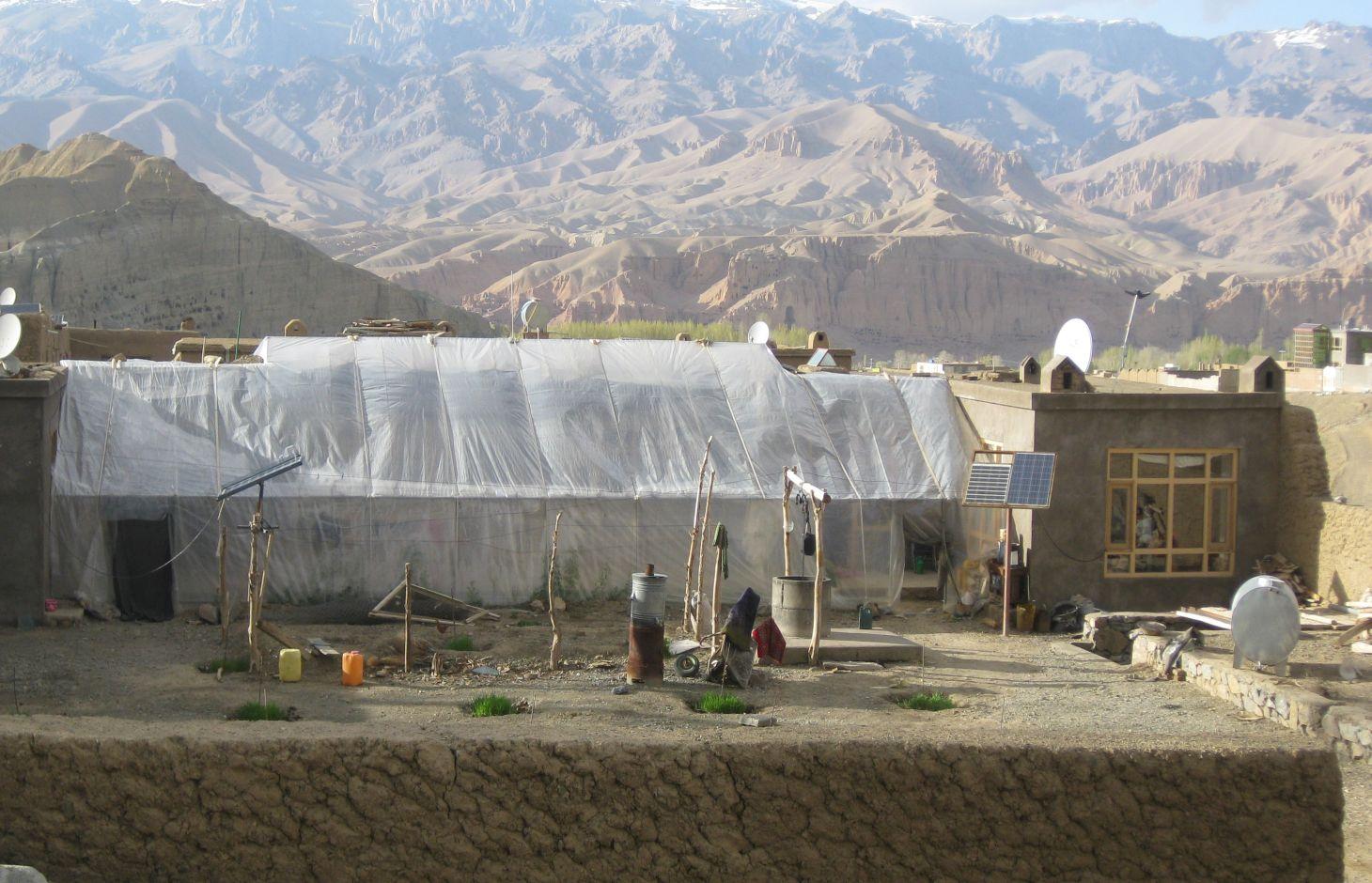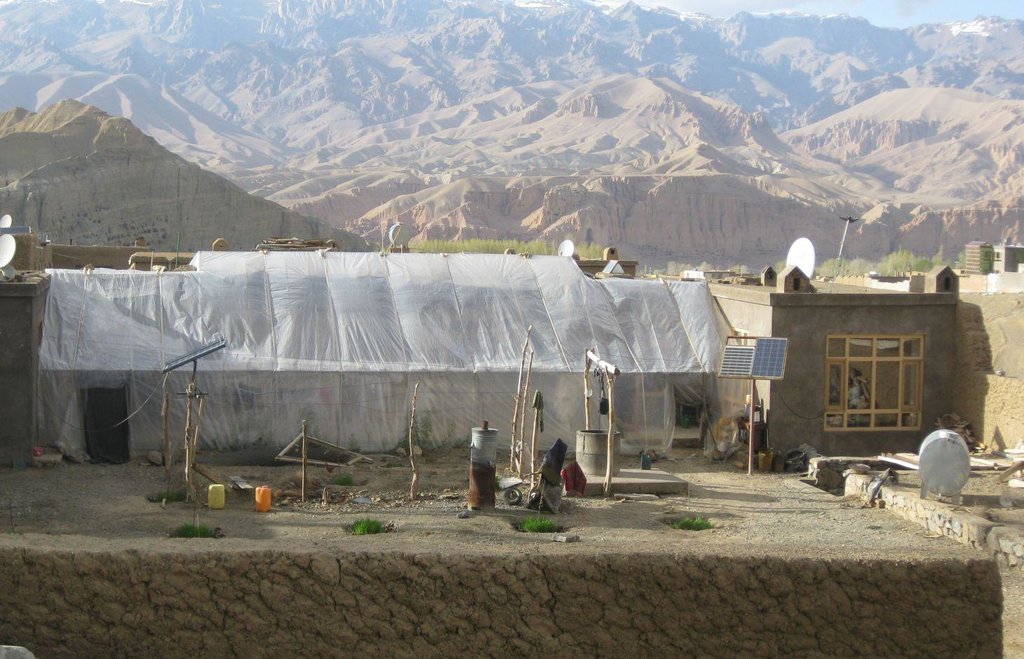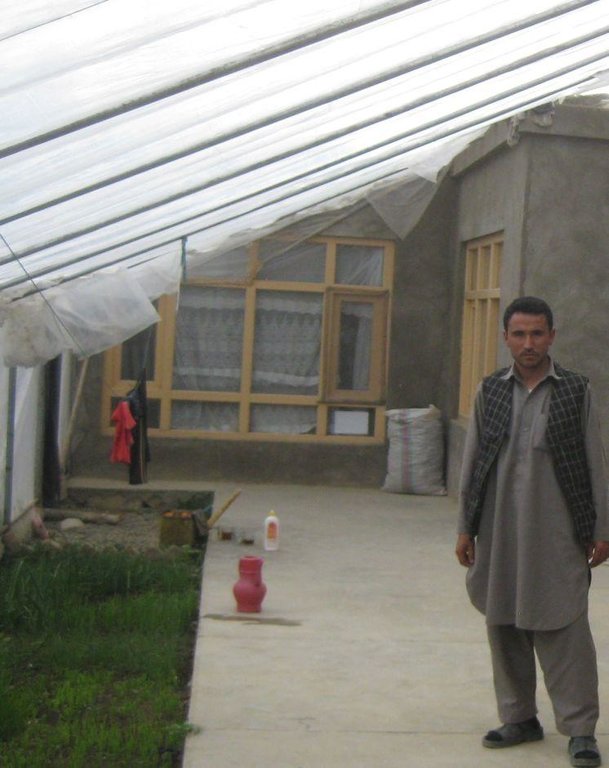Passive Solar House (PSH) [阿富汗]
- 创建:
- 更新:
- 编制者: Aqila Haidery
- 编辑者: –
- 审查者: Deborah Niggli, Alexandra Gavilano
Garm Khana
technologies_1602 - 阿富汗
查看章节
全部展开 全部收起1. 一般信息
1.2 参与该技术评估和文件编制的资源人员和机构的联系方式
SLM专业人员:
SLM专业人员:
有助于对技术进行记录/评估的机构名称(如相关)
HELVETAS (Swiss Intercooperation)1.3 关于使用通过WOCAT记录的数据的条件
编制者和关键资源人员接受有关使用通过WOCAT记录数据的条件。:
是
1.4 所述技术的可持续性声明
这里所描述的技术在土地退化方面是否存在问题,导致无法被认为是一种可持续的土地管理技术?:
否
2. SLM技术的说明
2.1 技术简介
技术定义:
A clean energy technology for converting solar energy into heat for warming homes.
2.2 技术的详细说明
说明:
Passive Solar House technology is documented by Sustainable Land Management Project/HELVETAS Swiss Intercooperation with financial support of Swiss Agency for Development and Cooperation.
Households in Bayman Centre experience very cold winters and meeting household energy needs for the Bamyan population is challenging. They mostly rely on unsustainable solutions such as burning manure or mountain shrubs. Shrub harvesting for firewood is a major cause of land degradation in the province. Fuel expenses also deplete the financial resources of an already impoverished population. Also, due to the intense cold, very few activities are possible during the winter. To overcome the challenges of heavy dependence on biomass for winter heating and to improve living conditions, many families in Bamyan Centre are adopting the passive solar technology for improving their living conditions, while reducing pressure on environment.
Passive solar technology captures sunlight in a room or building, and converts that energy into low-temperate heat. It provides an efficient mean of capturing the sun's energy, reducing the need for fuel wood and coal for heating.
(1)The passive solar house (PSH) technology has significant economic, socio-cultural and environmental benefits. They are as follows:
(2)reducing the reliance on shrubs and other heating materials; saving expenditure on fuel (aprox.25,000 Afghani/year) and the time usually spent on harvesting bushes;
(3)provision of extra space in the house for washing/drying cloths, bathing, social activities, play and study area, space for vegetable crops for home consumption; savings due to this technology offset the high initial investment cost;
(4)improved health due to less exposure to cold;
(5)reduced pressure on environment. The technology contributes to re-greening of common lands or rangelands where fewer shrubs are collected (uprooted) for firewood.
PSH should have a Southern exposure to take maximum advantage of the sun for daylight and passive solar heating. Most of the houses in Bamyan have southern exposures. The PSH is generally used for 6 months (November to April).
Although the technology was introduced in Bamyan by GERES, an International Non-Governmental Organization, many families have replicated it without any external support.
The main purpose of Passive Solar House technology is to make use of the solar energy for heating homes. As a result, the need for shrubs and coal for home heating is reduced significantly. The technology contributes to re-greening of common lands or range lands on which shrubs are harvested (uprooted) for firewood. Barat Ali's family bought about 60 donkey loads of shrubs per year for winter heating purposes. They did not have to do that after this technology was implemented by the PSH owner. The technology also contributes to the well-being of all family members, especially of women, who can do their household chores, and children who often got sick due to cold exposure.
The PSH presented here was established in September 2013 before the onset of winter. A transparent plastic sheet, metal pipes, wires and ropes to hold the plastic are used for construction work. Metal pipes were purchased from Kabul by the owner.
The PSH measures 17 m in length, 5 m in width and about 4 m in height. However, the PSH may vary from one house to another. The factor to consider is that the PSH should have long area to capture maximum sunlight. The upper part is slopping (about 30% gradient) to drain the water and snow. Local semi-skilled labor and skilled mechanic for welding the pipes were employed for construction works.
Approximately 45,000 Afghani/790 USD was spent on the construction of this PSH. The owner made significant investment. He purchased the pipes and plastic contributing approximately 70% of the costs. Plastic sheets, which are available on the market in Bamyan, are not of very high quality and have to be replaced each year. If the used plastic sheet is not too damaged, it is placed on roofs to protect from snow water/rain seepage. Otherwise, it is simply thrown away, which is not an environment friendly practice.
According to the PSH owner, a possibility for improvement is to use good quality wooden frame instead of pipes so that the plastic sheet can be kept intact by nailing it to the wooden frame. Using wooden frames may also reduce the cost of the technology, making it more affordable for poor families. Provision for ventilation is an aspect which needs to be considered while constructing PSH.
Bamyan province is a remote province of Afghanistan with high poverty rate. It has a temperate and arid climate. During winter, temperatures can drop below minus 22 degrees. Summer temperature can reach up to 34 degrees in the month of July. The average annual rainfall in the area is about 230 mm and some years can be very dry.
90% of the population relies on subsistence agriculture for their livelihoods and off-farm activities are marginal.
2.3 技术照片
2.5 已应用该技术的、本评估所涵盖的国家/地区/地点
国家:
阿富汗
区域/州/省:
Bamyan
有关地点的进一步说明:
Bamyan Center / Dashte Esakhan
具体说明该技术的分布:
- 均匀地分布在一个区域
如果技术均匀分布在一个区域,则指定覆盖的区域(单位为平方千米):
0.00027
如果不知道精确的区域,请注明大致覆盖的区域:
- < 0.1 平方千米(10 公顷)
注释:
Total area covered by the SLM Technology is 0.00027 km2.
The PSH and house areas are 85 and 270 square meter, respectively.
2.6 实施日期
如果不知道确切的年份,请说明大概的日期:
- 不到10年前(最近)
2.7 技术介绍
详细说明该技术是如何引入的:
- 通过项目/外部干预
注释(项目类型等):
The PSH owner saw the technology applied by others and replicated it without any external support. The technology has been promoted by GERES (an International NGO) in Bamyan.
3. SLM技术的分类
3.1 该技术的主要目的
- 创造有益的社会影响
3.2 应用该技术的当前土地利用类型

定居点、基础设施
- 能源:管道、电线
注释:
Major land use problems (compiler’s opinion): Degradation of common lands due to shrub harvesting for firewood and overgrazing by sheep and goats.
Major land use problems (land users’ perception): Land degradation due to uprooting of shrubs required for domestic purpose like heating homes during winter and cooking.
Constraints of Infrastructure (House): Lack of alternative energy resources. Heavy dependence on biomass for burning.
Longest growing period in days: 180, Longest growing period from month to month: April-September
3.5 该技术所属的SLM组
- 节能技术
3.6 包含该技术的可持续土地管理措施

结构措施
- S11:其它
注释:
Specification of other structural measures: Passive Solar House
3.7 该技术强调的主要土地退化类型

生物性退化
- Bc:植被覆盖的减少
注释:
Main causes of degradation: over-exploitation of vegetation for domestic use (Shrubs for fuel wood), overgrazing (Mainly sheep and goats), governance / institutional (Specially relating to common lands), lack of alternative energy options
Secondary causes of degradation: droughts, population pressure
3.8 防止、减少或恢复土地退化
具体数量名该技术与土地退化有关的目标:
- 防止土地退化
- 减少土地退化
4. 技术规范、实施活动、投入和成本
4.1 该技术的技术图纸
技术规范(与技术图纸相关):
Technical specification of South facing Passive Solar House constructed by the house owner comprising white plastic sheet, pipes for framers, string tied outside to secure plastic. Entrance gates.
Location: Dashte Esakhan. Bamyan Centre
Date: 12.05.2014
Technical knowledge required for field staff / advisors: moderate
Technical knowledge required for land users: moderate
Main technical functions: improvement of ground cover
Structural measure: Passive Solar House
Height of bunds/banks/others (m): 4
Width of bunds/banks/others (m): 5
Length of bunds/banks/others (m): 17
Construction material (other): Plastic sheet, metal pipes, wires
作者:
SLM Project, Helvetas, HELVETAS Swiss Intercooperation Afghanistan
4.2 有关投入和成本计算的一般信息
其它/国家货币(具体说明):
Afghani
如相关,注明美元与当地货币的汇率(例如1美元=79.9巴西雷亚尔):1美元=:
57.0
4.3 技术建立活动
| 活动 | 时间(季度) | |
|---|---|---|
| 1. | Purchase material from Kabul | September 2013 |
| 2. | Construction of PSH using 4 semi-skilled workers for 3 days and one skilled mechanic | September 2013 |
4.4 技术建立所需要的费用和投入
| 对投入进行具体说明 | 单位 | 数量 | 单位成本 | 每项投入的总成本 | 土地使用者承担的成本% | |
|---|---|---|---|---|---|---|
| 劳动力 | labour | ha | 1.0 | 190.12 | 190.12 | 100.0 |
| 设备 | plastic | ha | 1.0 | 70.28 | 70.28 | 100.0 |
| 设备 | pipes | ha | 1.0 | 530.31 | 530.31 | 100.0 |
| 技术建立所需总成本 | 790.71 | |||||
| 技术建立总成本,美元 | 13.87 | |||||
注释:
Duration of establishment phase: 1 month(s)
4.5 维护/经常性活动
| 活动 | 时间/频率 | |
|---|---|---|
| 1. | Maintainance - plastic sheet | As required |
| 2. | Replacement of plastic sheet every year |
4.6 维护/经常性活动所需要的费用和投入(每年)
| 对投入进行具体说明 | 单位 | 数量 | 单位成本 | 每项投入的总成本 | 土地使用者承担的成本% | |
|---|---|---|---|---|---|---|
| 劳动力 | labour | ha | 1.0 | 13.78 | 13.78 | 100.0 |
| 设备 | plastic | ha | 1.0 | 68.92 | 68.92 | 100.0 |
| 技术维护所需总成本 | 82.7 | |||||
| 技术维护总成本,美元 | 1.45 | |||||
注释:
Machinery/ tools: Plastic Sheets, Pipes, Wires, Generator, Welding Machine
The prices in Afghani are for September 2013. The exchange rate which was used for the conversion of US$ to Afghani was 1 US$ = 57 Afghani.
4.7 影响成本的最重要因素
描述影响成本的最决定性因素:
Pipes is the most expensive part of this technology
5. 自然和人文环境
5.1 气候
年降雨量
- < 250毫米
- 251-500毫米
- 501-750毫米
- 751-1,000毫米
- 1,001-1,500毫米
- 1,501-2,000毫米
- 2,001-3,000毫米
- 3,001-4,000毫米
- > 4,000毫米
有关降雨的规范/注释:
Most rainfall in spring (April and May) and also there is snow.
农业气候带
- 半干旱
Thermal climate class: temperate. Bamyan has cold winter (temperatures can fall up to -22 degree C) and temperate summer.
5.2 地形
平均坡度:
- 水平(0-2%)
- 缓降(3-5%)
- 平缓(6-10%)
- 滚坡(11-15%)
- 崎岖(16-30%)
- 陡峭(31-60%)
- 非常陡峭(>60%)
地形:
- 高原/平原
- 山脊
- 山坡
- 山地斜坡
- 麓坡
- 谷底
垂直分布带:
- 0-100 m a.s.l.
- 101-500 m a.s.l.
- 501-1,000 m a.s.l.
- 1,001-1,500 m a.s.l.
- 1,501-2,000 m a.s.l.
- 2,001-2,500 m a.s.l.
- 2,501-3,000 m a.s.l.
- 3,001-4,000 m a.s.l.
- > 4,000 m a.s.l.
5.3 土壤
平均土层深度:
- 非常浅(0-20厘米)
- 浅(21-50厘米)
- 中等深度(51-80厘米)
- 深(81-120厘米)
- 非常深(> 120厘米)
土壤质地(表土):
- 粗粒/轻(砂质)
表土有机质:
- 中(1-3%)
5.4 水资源可用性和质量
地下水位表:
5-50米
地表水的可用性:
匮乏/没有
水质(未处理):
良好饮用水
5.5 生物多样性
物种多样性:
- 低
5.6 应用该技术的土地使用者的特征
非农收入:
- 收入的10-50%
相对财富水平:
- 平均水平
个人或集体:
- 个人/家庭
性别:
- 女人
- 男人
说明土地使用者的其他有关特征:
Land users applying the Technology are mainly common / average land users
Difference in the involvement of women and men: All the PSH construction work is done by men.
Population density: 10-50 persons/km2
Annual population growth: 2% - 3%
100% of the land users are average wealthy.
5.7 应用该技术的土地使用者使用的平均土地面积
- < 0.5 公顷
- 0.5-1 公顷
- 1-2 公顷
- 2-5公顷
- 5-15公顷
- 15-50公顷
- 50-100公顷
- 100-500公顷
- 500-1,000公顷
- 1,000-10,000公顷
- > 10,000公顷
这被认为是小规模、中规模还是大规模的(参照当地实际情况)?:
- 小规模的
5.8 土地所有权、土地使用权和水使用权
土地所有权:
- 个人,有命名
土地使用权:
- 个人
用水权:
- 个人
注释:
Well belongs to the house owner
5.9 进入服务和基础设施的通道
健康:
- 贫瘠
- 适度的
- 好
教育:
- 贫瘠
- 适度的
- 好
技术援助:
- 贫瘠
- 适度的
- 好
就业(例如非农):
- 贫瘠
- 适度的
- 好
市场:
- 贫瘠
- 适度的
- 好
能源:
- 贫瘠
- 适度的
- 好
道路和交通:
- 贫瘠
- 适度的
- 好
饮用水和卫生设施:
- 贫瘠
- 适度的
- 好
金融服务:
- 贫瘠
- 适度的
- 好
6. 影响和结论性说明
6.1 该技术的现场影响
社会经济效应
生产
能源生产
注释/具体说明:
For winter season
收入和成本
工作量
注释/具体说明:
Time saved in shrubs collection, burning Bukharis stoves for house warming, going out for daily chores like drying clothes, etc...
其它社会经济效应
Reduced expense on fuel (wood and coal)
注释/具体说明:
Due to less consumption of coal and shrubs
Off-season vegetable production for self consumption
注释/具体说明:
Harvested 5 times during winter/spring
Energy saving (coal bags)
注释/具体说明:
Less use of coal for winter heating
社会文化影响
食品安全/自给自足
注释/具体说明:
Due to increased fresh winter vegetable production. Cash saved can be used for buying food items.
健康状况
注释/具体说明:
Women, men and children are less exposed to severe cold. Also consumption of vegetables grown in the PSH contributes to food diversity and health. PSH also protects chimney smoke from outside entering the house.
文化机会
注释/具体说明:
PSH used for social meeting, children play and studies, washing/drying clothes, bathing etc.
SLM/土地退化知识
注释/具体说明:
In terms of reducing shrub cutting through alternative energy options. Others see and learn.
冲突缓解
contribution to human well-being
注释/具体说明:
The technology has contributed to less expenditure on fuel, improved health and has created socio-cultural opportunities.
生态影响
水循环/径流
地表径流
注释/具体说明:
As PSH has sloping top without any proper outlet for concentrated runoff
生物多样性:植被、动物
植物多样性
注释/具体说明:
As the family can grow certain vegetable crops and flowers inside the PSH during winter time.
减少气候和灾害风险
碳和温室气体的排放
注释/具体说明:
Because of less burning of coal and shrubs
6.2 该技术的场外影响已经显现
Increased vagetation cover
注释/具体说明:
Due to less extraction of shrubs for firewood for winter heating
Reduced soil erosion
注释/具体说明:
Estimated
6.3 技术对渐变气候以及与气候相关的极端情况/灾害的暴露和敏感性(土地使用者认为的极端情况/灾害)
气候有关的极端情况(灾害)
气象灾害
| 该技术是如何应对的? | |
|---|---|
| 局地风暴 | 不好 |
其他气候相关的后果
其他气候相关的后果
| 该技术是如何应对的? | |
|---|---|
| Intense sun light | 不好 |
注释:
Pipes should be replaced by wooden frames because they get heated up and can damage the plastic. Also, using wooden frames may reduce the cost.
6.4 成本效益分析
技术收益与技术建立成本相比如何(从土地使用者的角度看)?
短期回报:
中性/平衡
长期回报:
非常积极
技术收益与技术维护成本/经常性成本相比如何(从土地使用者的角度看)?
短期回报:
积极
长期回报:
非常积极
注释:
The cost of the PSH can be covered in 2 years time. This is only in financial terms but if we analyse the overall economic benefits considering health and ecological benefits, the benefits compared with establishment costs will be more.
6.5 技术采用
在所有采用这项技术的人当中,有多少人是自发的,即未获得任何物质奖励/付款?:
- 91-100%
注释:
100% of land user families have adopted the Technology without any external material support
30 land user families have adopted the Technology without any external material support
There is a moderate trend towards spontaneous adoption of the Technology
6.7 该技术的优点/长处/机会
| 土地使用者眼中的长处/优势/机会 |
|---|
| Multiple benefits for the family - less expense for fuel, children can play inside in warm climate. It is also a good space for social meetings. |
| 编制者或其他关键资源人员认为的长处/优势/机会 |
|---|
| PSH has multiple benefits: house warming using clean energy, less expenditure on fuel for winter, extra room for various activities (like studies, playing, washing, drying clothes, warming water, social meetings), less use of shrubs. |
| Due to PSH technology, families dependency on shrubs for firewood is reduced which leads to improved land management. |
| Convinced by the benefits of PSH technology, many families with financial resources have constructed it without seeking external support. |
6.8 技术的弱点/缺点/风险及其克服方法
| 土地使用者认为的弱点/缺点/风险 | 如何克服它们? |
|---|---|
| Metal pipe is not good for frame because the plastic sheet cannot be nailed to it so that it does not get blown away by wind. | Use of wooden frame. |
| Distance between pipes is more. | More pipes needed to reduce that gap. |
| The air moisture can increase in the PSH as well as in the other parts of the house. | The door and if possible the window of the PSH should be opened for some minutes during the day. |
| 编制者或其他关键资源人员认为的弱点/缺点/风险 | 如何克服它们? |
|---|---|
| PSH does not have proper ventilation. | Construction of a ventilator. |
| The poor households cannot apply it due to high establishment cost. | Use of low cost wooden frame and some incentives to the poor families for establishment. |
7. 参考和链接
7.1 信息的方法/来源
- 实地考察、实地调查
- 与土地使用者的访谈
(现场)数据是什么时候汇编的?:
12/05/2014
链接和模块
全部展开 全部收起链接
无链接
模块
无模块




